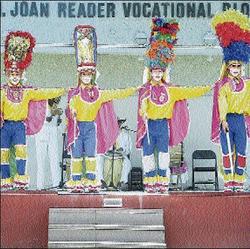Marcia Rowe, Gleaner Writer

Artistes from the Corporacion Cultural de Barranquilla, under the auspices of the Colombian Ministry of Foreign Affairs, entertain students with select dances from Barranquilla's Carnival, at St Andrew High School for Girls, recently. - Photo by Marcia Rowe/Freelance Photographer
Exposing students to different cultures enables them to understand, recognise and appreciate the similarities between their culture and that of others.
So it was on Friday, June 6, when a group of artistes, from the Corporacion Cultural de Barranquilla, under the auspices of the Colombian Ministry of Foreign Affairs, entertained students with select dances from Barranquilla's Carnival, at St Andrew High School for Girls' garden theatre.
Students from St Andrew High and St Andrew Preparatory schools were treated to a display of colourful costumes and traditional expression through dance and music.
To screams of joy from the young audience the 15-member ensemble began its cultural extravaganza with a dance narrative entitled, 'Congo'.
Negative force
The dance seems to be about people who are being attacked by a negative force, but was saved by some Colombian women, represented by the Colombian flag.
The costumes for Congo were spectacular. The male dancers wore beautifully and well-decorated headgear, complemented by yellow long-sleeved shirts, blue pants decorated with white and gold attachments, finishing with pink cloaks draped over their backs.
While the women wore wide, flowing red, black and gold dresses. The Devil, or present evil, wore full black, including a cloak, and a skeleton painted from chest to knees.
The screams continued for the dance, 'Cumbia', which despite the similarity in the name to Kumina, one of Jamaica's traditional dances, it has more similarity to another Jamaican traditional dance, Dinki Mini, especially the beginning called Sound the Cumbia.
The word cumbia is derived from the word cumbč which means falling in love. Thus the dance explores relationship. In this case, the story is based on men who appear to love liquor and are properly scolded by their partners. The costumes for 'Cumbia' comprised all white for men and red and white skirts and blouses for the women.
Disguise
But the loudest and more sustained screams from the audience of predominantly 12 to 15-year-old girls was for the dance, 'Mapalé'. The word mapale has its origins in an old Guinea word meaning fish.
Mapale comprises two levels. On the outset it seems to be a dance about lovers meeting, but on the other level, it tells the story of slaves who use romance as a disguise to plan their escape from their Spanish masters.
The group of Colombian dancers, who are descendants of Africans, mainly from Guinea, the Ivory Coast and some parts of Nigeria, was guided by choreographer Monica Lindo.

